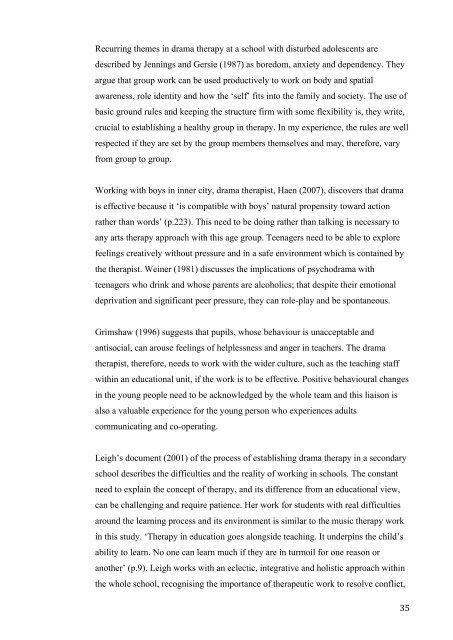Derrington 2012 thesis.pdf - Anglia Ruskin Research Online
Derrington 2012 thesis.pdf - Anglia Ruskin Research Online
Derrington 2012 thesis.pdf - Anglia Ruskin Research Online
Create successful ePaper yourself
Turn your PDF publications into a flip-book with our unique Google optimized e-Paper software.
Recurring themes in drama therapy at a school with disturbed adolescents are<br />
described by Jennings and Gersie (1987) as boredom, anxiety and dependency. They<br />
argue that group work can be used productively to work on body and spatial<br />
awareness, role identity and how the ‘self’ fits into the family and society. The use of<br />
basic ground rules and keeping the structure firm with some flexibility is, they write,<br />
crucial to establishing a healthy group in therapy. In my experience, the rules are well<br />
respected if they are set by the group members themselves and may, therefore, vary<br />
from group to group.<br />
Working with boys in inner city, drama therapist, Haen (2007), discovers that drama<br />
is effective because it ‘is compatible with boys’ natural propensity toward action<br />
rather than words’ (p.223). This need to be doing rather than talking is necessary to<br />
any arts therapy approach with this age group. Teenagers need to be able to explore<br />
feelings creatively without pressure and in a safe environment which is contained by<br />
the therapist. Weiner (1981) discusses the implications of psychodrama with<br />
teenagers who drink and whose parents are alcoholics; that despite their emotional<br />
deprivation and significant peer pressure, they can role-play and be spontaneous.<br />
Grimshaw (1996) suggests that pupils, whose behaviour is unacceptable and<br />
antisocial, can arouse feelings of helplessness and anger in teachers. The drama<br />
therapist, therefore, needs to work with the wider culture, such as the teaching staff<br />
within an educational unit, if the work is to be effective. Positive behavioural changes<br />
in the young people need to be acknowledged by the whole team and this liaison is<br />
also a valuable experience for the young person who experiences adults<br />
communicating and co-operating.<br />
Leigh’s document (2001) of the process of establishing drama therapy in a secondary<br />
school describes the difficulties and the reality of working in schools. The constant<br />
need to explain the concept of therapy, and its difference from an educational view,<br />
can be challenging and require patience. Her work for students with real difficulties<br />
around the learning process and its environment is similar to the music therapy work<br />
in this study. ‘Therapy in education goes alongside teaching. It underpins the child’s<br />
ability to learn. No one can learn much if they are in turmoil for one reason or<br />
another’ (p.9). Leigh works with an eclectic, integrative and holistic approach within<br />
the whole school, recognising the importance of therapeutic work to resolve conflict,<br />
! $&!
















